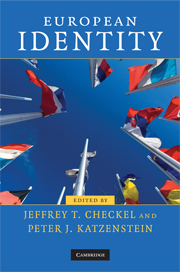Book contents
- Frontmatter
- Contents
- List of figures
- List of tables
- List of contributors
- Preface
- 1 The politicization of European identities
- Part I European identity as project
- Part II European identity as process
- 5 Being European: East and West
- 6 Who are the Europeans and how does this matter for politics?
- 7 Immigration, migration, and free movement in the making of Europe
- Part III European identity in context
- Bibliography
- Index
6 - Who are the Europeans and how does this matter for politics?
Published online by Cambridge University Press: 05 June 2012
- Frontmatter
- Contents
- List of figures
- List of tables
- List of contributors
- Preface
- 1 The politicization of European identities
- Part I European identity as project
- Part II European identity as process
- 5 Being European: East and West
- 6 Who are the Europeans and how does this matter for politics?
- 7 Immigration, migration, and free movement in the making of Europe
- Part III European identity in context
- Bibliography
- Index
Summary
The European Union has produced a remarkable set of agreements to guide the political interactions of countries across Europe in the past fifty years. These agreements have produced collective rules governing market transactions of all varieties, created a single currency, established a rule of law that includes a European court, and promoted increased interactions for people who live within the boundaries of Europe. Moreover, the EU has expanded from six to twenty-seven countries. The endpoint of the EU has been left intentionally vague and can be encapsulated by the ambiguous phrase “toward an ever closer union.”
Much of the political criticism of the EU has focussed on the lack of transparency in its procedures and in its accountability to a larger democratic public (Baun 1996; Dinan 2002; McCormick 2002). Many of Europe's citizens have little knowledge about the workings of the EU (Gabel 1998). This lack of “connectedness” to the EU by ordinary citizens has caused scholars to try to understand why a European identity (equivalent to a “national” identity), a European “civil society,” and a European politics have been so slow to emerge (Laffan et al. 2000). The main focus of these efforts is why, after fifty years of the integration project, there is so little evidence of public attitudes that reflect more feelings of solidarity across Europe. Even among those who work in Brussels, there are mixed feelings about being European (Hooghe 2005; Beyer 2005).
- Type
- Chapter
- Information
- European Identity , pp. 132 - 166Publisher: Cambridge University PressPrint publication year: 2009
- 39
- Cited by



